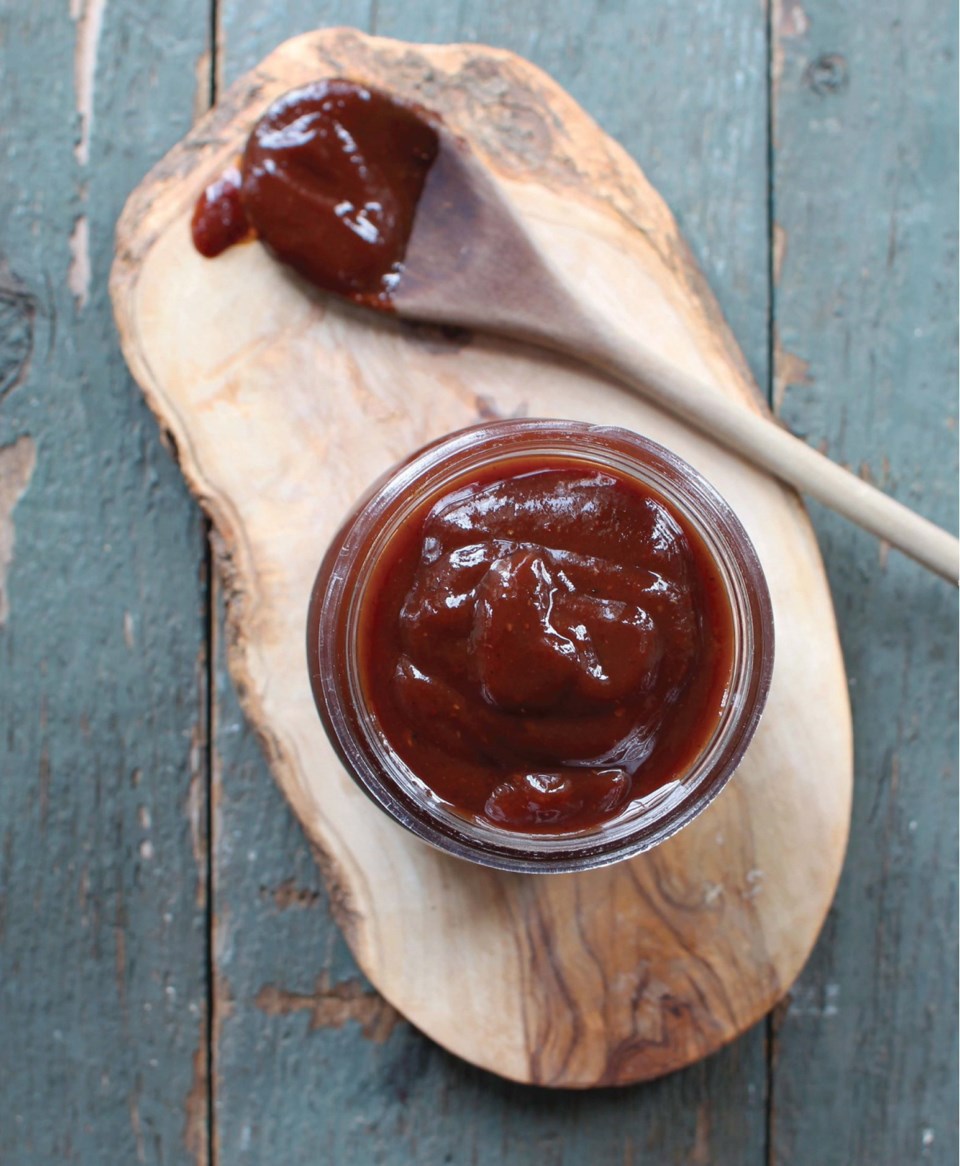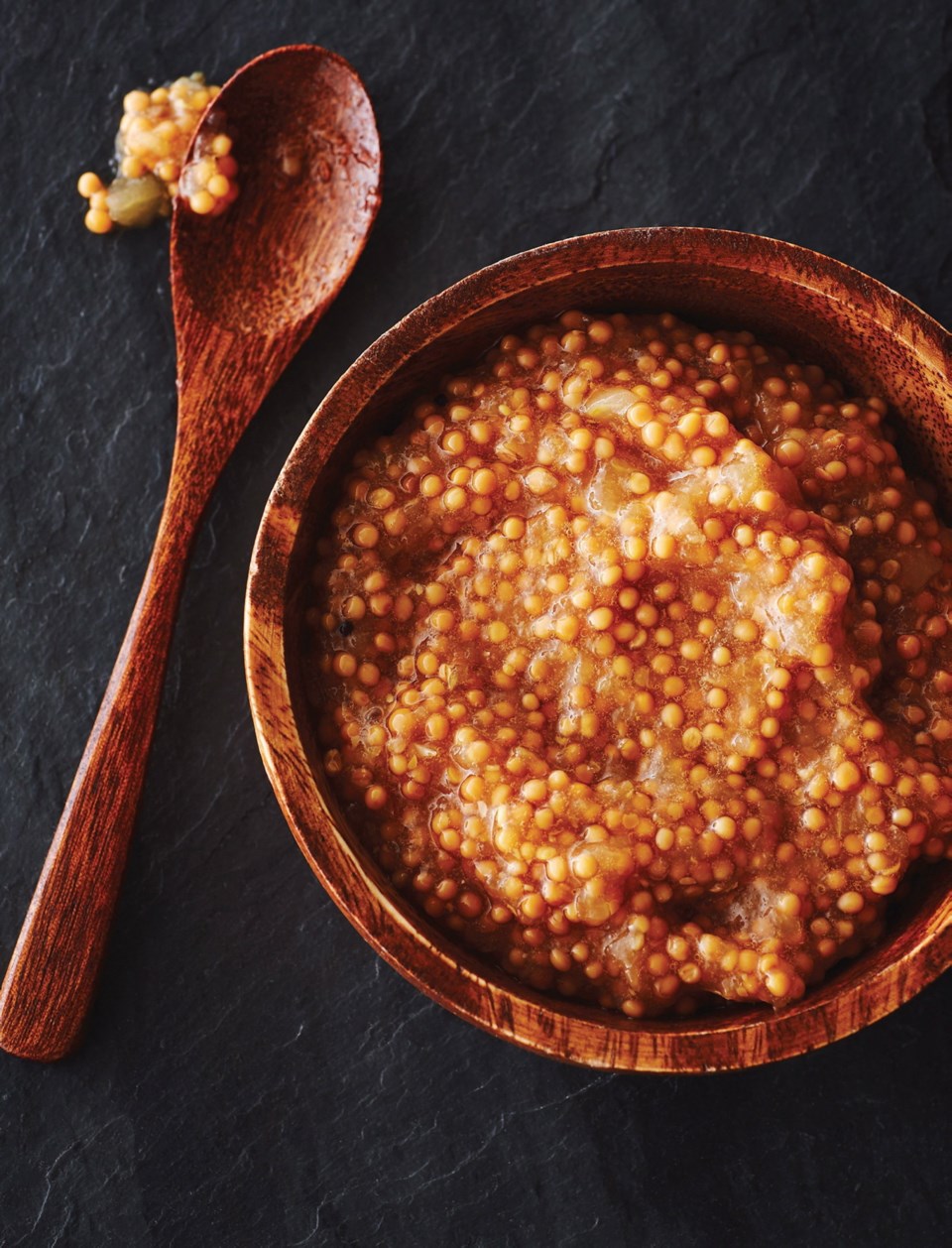TORONTO — While there’s a huge range of prepared condiments available — and more hitting the market all the time — many home cooks are discovering how easy it is to whip up their own.
“People are paying close attention to where their ingredients are coming from,” said Toronto chef Corbin Tomaszeski. “They want to have the ability to say: ‘I made this from scratch.’
“I find that once people understand how simple it is to make them on your own they get more and more excited about doing it and then coming up with … personalized versions.”
From homemade sauces, rubs and marinades with international influences, to relish, mustard, ketchup and pickles, cooks are discovering ways to make their barbecues feel more artisanal.
They’re also prepping condiments for gifts, said grilling expert Steven Raichlen, who suggested possibilities including coffee rub, port mustard, ginger pear chutney, corn relish, mango mint ketchup or bacon bourbon barbecue sauce, which can all be packaged in an attractive jar with a hand-written label.
Novices can easily put together a delicious rub from ingredients they are likely have on hand. Raichlen’s basic rub — equal portions of salt, pepper, brown sugar and paprika — is a harmonious formula of sweet, salty, sour and hot, which offers a hit of flavour to pork, beef, chicken and robust fish such as salmon.
Tomaszeski likes to include cumin for its aromatic nuttiness and to add a Middle Eastern, South Asian or Mexican influence to his rubs.
“Cumin, oregano, brown sugar, onion, garlic, with a little bit of paprika is a winner every single time. Put in some cracked black pepper. If you want to add more heat, put in cayenne,” said Tomaszeski, whose latest venture is Savoury, a private dining room designed to mimic the feel of eating with the chef in his home, which is hidden in the back of the Westin Harbour Castle’s main kitchen.
“You can use it as a rub on your ribs. You can sprinkle it on chicken drumettes. You can sprinkle it on just vegetables on a skewer.
“It is a beautiful essence that you can add as a rub into the meat to get into the fibres or just as a quick sprinkle.”
Canada cuts the mustard as the second-largest producer in the world and exports more of this valuable crop than any other country. The beloved ballpark staple is made from finely ground yellow mustard seed and turmeric, which adds more depth of colour, along with vinegar and water. But it’s easy to make variations with brown or black seeds crushed or left whole, honey, different vinegars, beer, port, spirits, horseradish or herbs.
That other staple condiment — ketchup — originated in China, not North America, and was imported to the West three centuries ago, said Raichlen, author of the new book Barbecue Sauces, Rubs and Marinades — Bastes, Butters and Glazes, Too.
He’s always on the lookout for flavour inspiration when travelling.
A surprising discovery was the curiously named Monkey Gland Sauce, a sweet-spicy blend of chutney, wine and hot sauce from South Africa that actually doesn’t contain any primate parts.
Raichlen, who recently wrapped filming on the new TV show L’Atelier du Maitre du Grill for Zeste TV in Quebec, found another distinctive marrying of international flavours in a barbecue joint in Atlanta run by a husband from Texas and wife from Seoul, South Korea. They marinate pork shoulder in gochujang, a Korean fermented chili paste, and use the American soft drink Sprite in the sauce.
Raichlen said home grillers often err on when they add barbecue sauce to grilled foods.
“I use it as a lacquer right at the end. I cook ribs for two to three hours over an indirect or smoking process, pull them off, brush them with sauce and put them over the hot fire just for three minutes on the hot side of the grill just to sizzle or sear, char that sauce into the meat.
“The place for barbecue sauce is on the side, not on top. Taste the meat first and appreciate that quality of it, then add the barbecue sauce as a condiment.”
Many chefs and cookbook authors are also experimenting with homemade pickles to add crunch and piquancy to meals in as little as 20 minutes.
British celeb Nigella Lawson confessed to an obsession with “quick pickling” during a Toronto interview to promote her last cookbook, Simply Nigella.
She says her pickled favourites, which range from peppers and carrots to beets, ginger and eggs, require no special equipment or skills.
“I do think sometimes I want to have a sudden injection of something spiky and sprightly and sour in it and that’s where my pickles come in,” she says. “But I also do them quite small scale. I make enough for a jar.”

Recipes
Barbecue sauces can have dozens of variations through the addition of such ingredients as fresh ginger, wasabi, miso, hoisin sauce, garlic, herbs, spices, coffee, wine and bacon, but the one component it must have is balance, said grilling expert and author Steven Raichlen.
“Feel free to mix and match with everything,” but the goal of any good sauce is to meld the contrasting elements — sweet, sour, salty, aromatic, hot — into a harmonious whole, he said.
As we head out to enjoy our outdoor kitchens, here is an assortment of recipes to try to enhance grilled food.
Sweet and Smoky Blueberry Ale Barbecue Sauce
While researching their cookbook Feast, Lindsay Anderson and Dana VanVeller spent a summer day in Kenora, Ont., on Lake of the Woods, rounding it off with a few great ales on the sunny patio of local craft brewpub Lake of the Woods Brewing Company. This barbecue sauce is courtesy of the brewery.
They suggest it’s particularly good on ribs or grilled chicken.
Makes: Four cups
1/4 cup lightly packed brown sugar
1/2 cup apple cider vinegar
1/4 cup molasses
1/4 cup honey
1/2 cup Lake of the Woods’ Forgotten Lake Blueberry Ale or any other mild ale
1/4 cup Worcestershire sauce
1/4 cup dark rum
2 Tbsp yellow mustard
1 Tbsp liquid smoke
1 Tbsp chili powder
2 tsp freshly ground black pepper
2 tsp ground allspice
1/4 tsp ground cloves
1/4 cup fresh or thawed frozen wild blueberries
3 1/2 cups ketchup
In a medium pot, combine sugar, vinegar, molasses, honey, beer, Worcestershire, rum, mustard, liquid smoke, chili powder, pepper, allspice and cloves and bring to a boil. Once boiling, reduce heat and simmer until mixture reduces by about a third, 40 to 60 minutes.
Add blueberries and ketchup and simmer for 30 minutes. Remove from heat and let cool. In a blender or with an immersion blender, purée until smooth. Transfer to an airtight container and refrigerate for up to one month or freeze for up to three months.
Source — Feast: Recipes and Stories From a Canadian Road Trip by Lindsay Anderson and Dana VanVeller (Appetite by Random House, 2017).
Made-From-Scratch Ketchup
This citrusy ketchup blurs the boundary between traditional ketchup and chutney and can be used pretty much as you would any commercial ketchup. Orange and lemon add an unexpected tropical touch that’s reinforced by the ginger and allspice, says Raichlen.
Makes: Four cups
2 Tbsp extra-virgin olive oil
1 small onion, finely chopped
2 cloves garlic, peeled and minced
1/2 cup red wine vinegar
1/2 cup packed dark brown sugar
1/2 cup honey
1/2 cup fresh orange juice
1 lemon, peeled (remove zest and rind),
seeded and diced
2 tsp coarse salt (sea or kosher)
2 tsp ground allspice
1 tsp ground ginger
1/2 tsp mustard powder
1/2 tsp freshly cracked black peppercorns
1/2 tsp ground cloves
1 can (28 oz) whole plum tomatoes (juices strained and reserved, tomatoes coarsely chopped by hand or in a food processor)
Heat olive oil in a medium non-reactive saucepan over medium heat. Add onion and garlic and cook until lightly browned, stirring with a wooden spoon, for four minutes.
Increase heat to high, stir in vinegar and brown sugar and boil until mixture is reduced by half, three to five minutes. Add honey, orange juice, lemon, salt, spices and reserved tomato juices. Reduce heat to medium and gently simmer, uncovered, until syrupy, five minutes.
Stir in chopped tomatoes and simmer ketchup, uncovered, until thick and flavourful, 20 to 30 minutes. The mixture should be concentrated but not too thick. Add water as needed.
Transfer mixture to a food processor and process to a coarse purée. Taste and adjust seasoning, adding salt, vinegar or any other ingredient; the ketchup should be highly seasoned. Transfer puree to jars, cover and let cool to room temperature. Refrigerate until serving. The ketchup will keep for several weeks in the refrigerator.
Source: Barbecue Sauces, Rubs and Marinades — Bastes, Butters and Glazes, Too by Steven Raichlen (Workman Publishing, 2017).
Canadian Mustard
You can pay tribute to one of Canada’s homegrown crops by making your own piquant mustard. This country is one of the world’s major producers of mustard seeds.
Yellow mustard seeds are only mildly spicy, so if you prefer real heat, use the much spicier brown seeds, suggests P.E.I. chef Michael Smith.
Makes: about two cups
1 cup yellow mustard seeds
1 cup sweet apple cider
1 cup cider vinegar
2 apples, unpeeled, cored and chopped
1/4 cup honey
2 tsp salt
In a medium pot, stir together mustard seeds, apple cider and cider vinegar. Cover tightly and rest at room temperature overnight.
Add apples, honey and salt. Bring to a simmer over medium heat and cook, stirring occasionally, until apple is very tender, 15 minutes or so. Let cool for a few minutes before transferring to a blender or food processor.
If you prefer whole-grain style mustard, pulse for just a few moments. For a smoother result, carry on until completely pureed. Transfer to a clean jar, seal tightly and refrigerate. The mustard keeps indefinitely.
Source: Real Food, Real Good by Michael Smith (Penguin Canada, 2016).
Monkey Gland Sauce
This sweet-spicy blend of chutney, wine and hot sauce is popular among South Africans at barbecues, says Raichlen.
“It’s really sweet with chutney and kind of tart with red wine. It’s two kinds of polls of South Africa’s origins, the British and the Indian with the chutney and the red wine with the French,” he explains.
This sauce is customarily served warm or at room temperature with grilled meats, such as steak and lamb chops. It can also be used for basting.
This version comes from the Mount Nelson Hotel in Cape Town.
For a variation, replace half the chutney with ketchup.
Makes: 1 1/4 cups; four to six servings.
1 cup fruit chutney
3 Tbsp dry red wine
3 Tbsp port wine
2 Tbsp salted butter
1 tsp piri piri sauce or your favourite hot sauce
1/2 tsp freshly ground black pepper
1/2 tsp liquid smoke
• coarse salt (sea or kosher)
In a heavy non-reactive saucepan over medium-high heat, combine all ingredients and bring to a boil. Reduce heat to medium and simmer sauce, uncovered, stirring often until chutney melts and sauce is richly flavoured, five to 10 minutes.
For a chunky sauce, serve as is. For a smooth sauce, purée in a food processor or blender.
Use immediately or transfer to a jar, cover and refrigerate. The sauce will keep for several weeks; bring to room temperature before serving.
Source: Barbecue Sauces, Rubs and Marinades — Bastes, Butters and Glazes, Too by Steven Raichlen (Workman Publishing, 2017).



